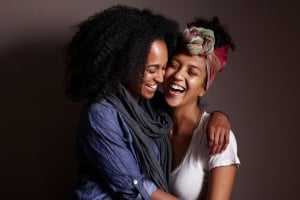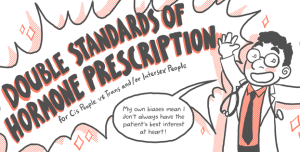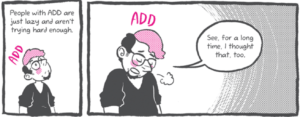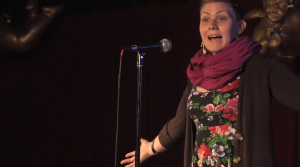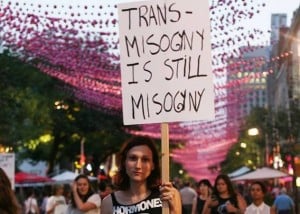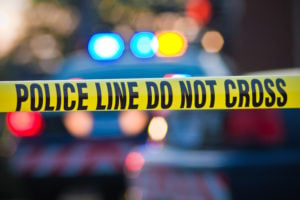
An out of focus police car with its lights shining, with yellow tape reading “POLICE LINE DO NOT CROSS” in focus across the scene.
As a Woman of Color in this country, it’s difficult for me to trust police officers.
Knowing the violent history of police and the continued harm they’ve done to my communities, it’s difficult to see police in a positive light. I feel nervous when I’m around them. I worry constantly about my loved ones who are also Black, queer, transgender, disabled, and of Color. I wake up worried that one of them will become a hashtag.
Living with this kind of fear is exhausting.
And it’s because I live with this fear that I can’t watch any feel-good police campaigns staged to “bridge the gap” between communities of color and law enforcement officers.
Y’all know the ones I’m talking about.
There’s the video of a police officer in Florida, who joins in a game of basketball after he was called on a noise complaint. There were many selfies of the First Steps Community Cookout between Black Lives Matter activists and Kansas police. And of course, who can forget the video of Virginia police pulling over Black people for violating “vehicle code 1.7.3.9.,” before giving them ice cream?
I don’t think these are cute, and I’m not the only one.
The fact of the matter is that none of these stunts are actually doing anything to address the violence that police inflict on communities of color. Giving someone ice cream doesn’t take into account the history of oppression ingrained in police systems. Playing basketball doesn’t count as a win when marginalized people are still being murdered. It does nothing to acknowledge that there is something inherently violent about policing.
True police reform can’t just be about publicity stunts. It has to be about truly making change that acknowledges and ends police violence.
Policy demands such as decriminalization of certain activities and ending the militarization of law enforcement can go a long way to ending police violence against People of Color.
But I don’t believe that we can rely solely on federal and state reforms to end police violence. I believe that it is imperative that police forces put aside their egos and aggression and actually begin to take in what communities are saying.
Communities must have a bigger role in how law enforcement operates in our neighborhoods. We must be active participants in the way we interact with one another and in how the police interact with us.
Below are just some solutions that put communities in the forefront of ending police violence.
1. Mandatory Social Justice Trainings
In 2015 in Minnesota, the American Civil Liberties Union presented an analysis and recommendations for law enforcement in Minneapolis. The analysis showed that Minneapolis police overcriminalized People of Color. The recommendations included implicit bias trainings and banning racial profiling.
This is important because it reflects a larger, nation-wide trend of policing.
Law enforcement should be taught a comprehensive history of the police system in the United States and how racism, ableism, homophobia, and transphobia have been inherent parts of the police system. This should include trainings on how stereotypes and implicit biases are not just “harmless” ideas, but how they lead to violence against marginalized people. Cops should be responsible for continuing to go to these trainings for as long as they are in service.
Programs like this are incredibly important because it really feels like the police are only around to perpetuate oppression. That is not only because of the violent and racist history of policing in the US, but how our punitive justice system continues to promote harm and discrimination.
The fact of the matter is, nothing that police officers do – from the laws that they swear to uphold to the split-second decisions they make in the field – happens within a vacuum. Instead, in happens within the very real, oppressive context of the United States.
I know a lot of people who laughed and scoffed when it was revealed that Jonathan Aledda said he didn’t know why he shot Charles Kinsey, a Black therapist. I know a lot of people who were shocked when another officer said Aledda was actually aiming at Arnaldo Rios, an autistic Latino who was merely playing with a toy truck.
The entire situation seemed bizarre. Why would the cops shoot at two innocent men who looked like they were complying with the police?
The truth is that this is what the police – and everyone else – are trained to do from birth. We as individuals have been live in a society that reinforces harmful ideas through institutions, media, and our own relationships. This is only exacerbated for police officers, who receive very little training and actively criminalize bodies of color.
While these biases disproportionately affect Black people for being “too aggressive,” like Mike Brown, they also affect other People of Color. Almost 20 years ago, police killed Kuanchung Kao because they were worried that he would harm them with “martial arts” moves.
2. Community-Police Patrol Teams
How would neighborhood patrols change if teams were made up of people who were from that neighborhood?
It’s important that more police officers reflect the communities that they serve. However, it is vital that communities have more control over who is surveying their neighborhood.
Formal patrol teams should also always have a neighborhood or community member with them. This community member can help train police on social and political norms in the neighborhood. They would film the police that they are patrolling with and be part of an oversight team that provides feedback on how police interact with the people and environment they work in.
Because of implicit bias, when police do not understand the cultural dynamics and people of a community, they don’t see folks as full people but as stereotypes. Simple social interactions, everyday norms and cultural traditions are automatically criminalized.
A couple of years ago, Jamie Kalani Rice, a Native Hawaiian man was peacefully performing a ritual towards a monk seal. A police officer, who didn’t understand the cultural or religious context of what Jamie was doing, assaulted and arrested him.
In 2014, Akai Gurley, a young Black man, was shot and killed by police who were patrolling in the stairwell of his Brooklyn apartment building. The police officers were not from the neighborhood; they simply assumed something dangerous was happening because of where they were.
According to the US Equal Employment Opportunity commission and the Census Bureau, in 75 of the nation’s largest cities, on average, 60% of police officers do not live within the city limits where they work. How can police “protect and serve” neighborhoods where they don’t know the culture and are frightened of the people?
Community patrolling is not a new idea, and we know it helps keep people safe. One of the first groups to do this was the Black Panther Party, who would follow police around to ensure that they were not harassing or illegally detaining folks. Today, organizations like CopWatch do similar things, by training volunteers to follow police, film their actions, and record any infractions that occur. These groups work in their neighborhoods to ensure that police didn’t violate community members’ rights.
3. Language Immersion Programs
According to a 2013 study by the Pew Research Center, after English, Spanish, Chinese, Indic languages like Hindi and Urdu, French and French Creole, and Tagalog are the most spoken languages in the United States, with millions of speakers.
And while Title VI of the Civil Rights Act of 1964 requires that all agencies that receive federal assistance – yes, including law enforcement – must “take reasonable steps to make their programs, services, and activities by eligible persons with limited English proficiency,” it seems that few police officers are actually trained in bridging language gaps.
In New York, where hundreds of languages are spoken, non-English speakers are often scared to call the cops because of language barriers. When police are called and arrive, they often are not bilingual or bring interpretation tools. This especially happens in cases of domestic violence. Spanish-speaking Latinas who have reported abuse have been mocked and arrested and their reports have gone un-translated, leading to further abuse and death.
Routinely, police abuse and kill people who cannot understand their orders.
Sureshbhai Patel and Kang Wong are both Asian men who were beaten up by police for non-compliance. In each case, the men and witnesses tried to explain that they did not speak English and didn’t understand the officers.
Just a month ago, Daniel Harris, a young Deaf man, was shot and killed by police after trying to communicate using sign language. John Williams and Edward Miller are also Deaf folks killed by police because they were seen as “threatening” or not complying with police officers.
When police officers do not understand the languages of the communities they work in, it can cause confusion and increased violence.
The Vera Institute of Justice and the National Association of the Deaf have comprehensive resources on how law enforcement can be held accountable for bridging language gaps. Police should have basic trainings of the languages that are spoken in their jurisdictions. Interpreters from these communities and materials in languages other than English should be widely made available to folks. Community members should be provided with surveys and be able to provide feedback on how well police are doing.
4. Mental Health Response Teams
According to the Washington Post, ¼ of people shot to death by police within the first half of 2015 were “in the throes of mental or emotional crisis.” They also reported that when the police were called in these situations, it was not because someone was reporting a crime but because a loved one was worried for the victim.
We have countless examples of neurodivergent and disabled folks being harmed and killed by police because they are not trained to work with these populations. It is also because of racist and ableist stereotypes that claim neurodivergent folks are inherently dangerous. Because police are not taught de-escalation tactics or even how to recognize some common behaviors, violence is exacerbated.
Earlier this summer, a Native woman, Loreal Tsingine, was shot and killed by police; they were originally called because she was “behaving erratically.” Last year in New York, police beat up Troy Canales, an autistic Black boy for no apparent reason. In New Jersey, police forcefully restrained and killed Santiago Villanueva, an epileptic Dominican man, while he was having a seizure.
Creating Mental Health Response Teams would ensure that in times of crisis, neurodivergent folks can get proper help and not be criminalized by police.
These would be teams of counselors, social workers, doctors, and other neurodivergent folks who could work with trained police to ensure that everyone remains safe. These teams would respond to 911 calls involving mental health crises and lead workshops for community members on what to do in during these times. These teams could use resource lists like those created by organizations like the Autism Self-Advocacy Network to ensure the voices of neurodivergent people are front and center.
5. Survivor-Driven Trainings and Partnerships
Police are not taught how to properly interact with victims and survivors of rape, domestic violence, and sexual assault.
Rather than providing protection, it has been documented again and again that police fail to provide adequate resources, further traumatize, and actually criminalize survivors. A study by the Associate Press also showed that over 1,000 police were fired because they had raped or sexually assaulted women themselves.
To repeat that: this isn’t the number of police who actually assault people or were reported – just the number that lost their badges.
This is especially true for Women of Color, who often have no protections, particularly for Native women and those who are undocumented and fear deportation if they go to law enforcement. Deciding to go to the police or not is often a no-win situation. For example, in Detroit, where many sexual assault victims are Black, police rarely investigated reports and didn’t submit rape kits for testing.
This summer in Baltimore, a gross exchange between a prosecutor and police officer on a rape case was leaked. In it, the prosecutor claimed, “This victim seems like a conniving little whore.”
Police desperately need training on how to work with survivors and victims of assault. They need to create partnerships with organizations who already do this work to ensure that folks always feel safe and comfortable reporting what has happened to them. They need competency trainings that are survivor-driven and do not victim-blame; there needs to be policies put in place that protect people, particularly trans women and sex workers, from police rape.
There also needs to be community oversight for how police handle physical evidence to ensure that things are not accidentally or deliberately left untested.
6. Banning Excessive and Deadly Use of Force
When police continue to shoot people after they’ve been restrained, taser young children, use illegal physical moves, and fire an obscene amount of bullets at someone, this proves that police officers use excessive, and often deadly, amounts of force.
Mapping Police Violence shows an interactive map of how many people, the majority of whom are Black, have been killed by police. According to Killed By Police, over 1,200 people were killed in 2015 by law enforcement.
Unfortunately, police who kill people often bear no repercussions. A 2014 report stated that although Customs and Border Protection agents have killed at least 46 people since 2004, there have been no formal disciplinary actions taken.
Police officers first and foremost need better training in negotiation and deescalation tactics. Using force should be every police officer’s last resort. Join Campaign Zero has an extensive list of things that police departments can do in order to limit the use of force. Police departments also need streamlined policies against deadly uses of force, standard reporting of use of force.
There needs to be community-controlled monitoring and accountability practices for when officers do use force. Furthermore, there needs to be direct civilian oversight to determine disciplinary action when police use excessive or lethal use of force. The Movement for Black Lives has an extensive explanation of how this can work.
7. Remove Police from Schools
Earlier this year in Chicago, a school security guard handcuffed a six-year-old Black girl, Madisyn Moore, for taking candy from a teacher’s desk. In 2015 South Carolina, a police officer violently dragged, flipped, and arrested a Black teenage girl while in class. Both Kiera Wilmot and Ahmed Mohammad were arrested while in school for creating STEM projects.
While these may seem like isolated incidents, they are not. More and more in communities of color, police presences are used to intimidate and justify violence against young people of color in schools. Rather than hiring more social workers or invest in restorative justice programs, public schools around the country have high numbers of police, metal detectors, and zero-tolerance polices under the guise of keeping students “safe.”
Instead, these actions only contribute to the School-to-Prison pipeline, which primarily target Black, Native, Latinx, disabled, and LGBTQIA+ students across the country. Students essentially begin to feel like criminals in a space that is supposed to be about learning and growing.
Cities need to remove police presences from schools altogether. Instead, funding should be used to hire social workers and teach conflict resolution programs and restorative justice practices to administration, faculty, and students. The Dignity in Schools Campaign, along with some other organizations, have an extensive issue brief explaining why increased police presence in schools only increases violence, not safety.
8. Know-Your-Rights Trainings
Unfortunately, knowing your rights when interacting with police will not stop violence or abuse.
However, knowing what you are legally allowed to do when interacting with police can be very useful, especially for marginalized folks who might not know that they have any rights when speaking to police.
People of Color are overrepresented in the criminal justice system but may be under-informed about their rights. And because police are not obligated to tell you what your rights are if you’re not being arrested, many people end up hurting their cases in the long-run.
I’m definitely not blaming folks for being targeted or assaulted by police. But knowing what our civil liberties and rights are can only be helpful in the long run. The more people who know and can share knowledge about our rights, the less law enforcement will be able to get away with stomping all over them.
Local law enforcement should be obligated to work with Know Your Rights organizations to ensure that police themselves are up-to-date on what their limits are when trying to “enforce the law.” Police should offer to co-teach these kinds of trainings to community members in order to show that they are also invested in civil liberties.
They should also be obligated to identify themselves and explain why they’re interacting with someone on the street. In New York, coalitions like Communities United for Police Reform have been pushing for the Right to Know Bill. Furthermore, local precincts need be obligated to keep a list of free resources at their front desk and on their websites for all community members.
There are many organizations out there, such as Cop Block and the American Civil Liberties Union, which have extensive Know Your Rights resources on their website. The National Lawyers Guild has a few Know Your Rights training booklets in different languages.
9. Community-Based Alternatives to Calling the Police
The fact of the matter is, even with these reforms, the police system will likely never be a system for marginalized people. So where exactly does that leave us, when we need help?
Many organizers and groups have come up with community-based alternatives to calling the police. These can include implementing neighborhood watches to look out for others, mediation programs amongst neighbors when issues arise, and alternative medical care if someone is physically harmed.
Alternative programs to calling the police can be useful because people who have made commitments to justice, care, and love to one another control them. These kinds of programs show that there can be alternatives to the United State’s punitive, criminal justice system. Campaigns like the Safe Neighborhood Campaign, which is part of Safe OUTSide the System, is one such program. The folks who are a part of this are committed to rethinking safety and creating new systems.
This What To Do Instead of Calling the Police document has a number of articles, resources, and organizations that reimagine what communities can look like without police intervention. Rather than relying on an historically oppressive system to keep us “safe,” these resources work through how we can re-envision safety and hold one another accountable.
This is just a basic list, and it’s important to know that there are many other alternatives that can end police violence against People of Color.
When we think about reducing violence, it’s always important to keep the communities affected at the center of these conversations. True change cannot just look nice on paper; it needs to push forward transformative possibilities. None of these reforms mean anything if they continue to marginalize folks in the name of “security.”
[do_widget id=’text-101′]
Jennifer Loubriel is a Contributing Writer for Everyday Feminism and a mixed race Afro-Puerto Rican from the Bronx. She is also a queer mujerista and child abuse survivor. She earned her B.A. from Oberlin College in Religion and English, and identifies as an amateur Latinx ethicist and a speculative fiction enthusiast. She is a co-founder and moderator over at the Tumblr Women of Color, in Solidarity, a safe space for and by women of color. You can usually find her writing about apocalypse and diaspora, rewatching her favorite TV shows, or taking selfies with her family’s cat.
Search our 3000+ articles!
Read our articles about:
Our online racial justice training
Used by hundreds of universities, non-profits, and businesses.
Click to learn more






